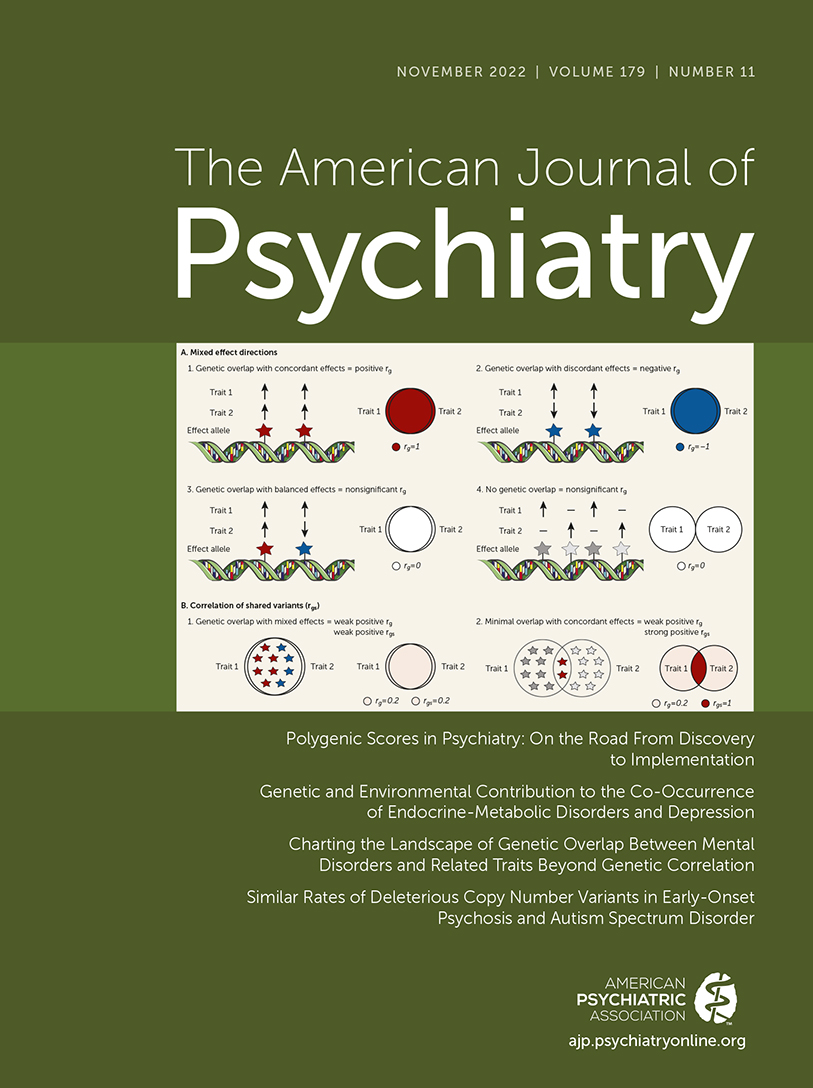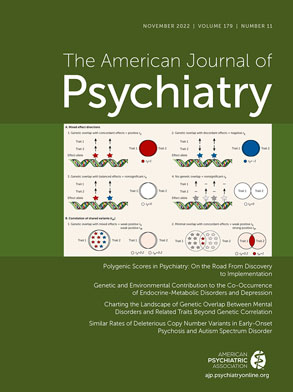Similar Rates of Deleterious Copy Number Variants in Early-Onset Psychosis and Autism Spectrum Disorder
Abstract
Objective:
Methods:
Results:
Conclusions:
Methods
EOP Samples
| Full EOP Sample (N=137) | EOP Without ASD or Intellectual Disability (N=89) | EOP Without Schizophrenia (N=99) | EOP Before Age 13 (N=101) | |||||
|---|---|---|---|---|---|---|---|---|
| Characteristic | N | % | N | % | N | % | N | % |
| Sex | ||||||||
| Male | 88 | 64.2 | 50 | 56.2 | 63 | 63.6 | 65 | 64.4 |
| Female | 49 | 35.8 | 39 | 43.8 | 36 | 36.4 | 36 | 35.6 |
| Race | ||||||||
| Asian or Pacific Islander | 3 | 2.2 | 3 | 3.4 | 2 | 2.0 | 2 | 2.0 |
| Black/African American | 21 | 15.3 | 15 | 16.9 | 16 | 16.2 | 12 | 11.9 |
| Two or more races | 2 | 1.5 | 2 | 2.2 | 0 | 0.0 | 2 | 2.0 |
| White | 90 | 65.7 | 56 | 62.9 | 65 | 65.7 | 67 | 66.3 |
| Unknown or not available | 21 | 15.3 | 13 | 14.6 | 16 | 16.2 | 18 | 17.8 |
| Ethnicity | ||||||||
| Hispanic/Latino | 22 | 16.1 | 15 | 16.9 | 16 | 16.2 | 15 | 14.9 |
| Not Hispanic/Latino | 91 | 66.4 | 62 | 69.7 | 66 | 66.7 | 67 | 66.3 |
| Unknown or not available | 24 | 17.5 | 12 | 13.5 | 17 | 17.2 | 19 | 18.8 |
| Age at psychosis symptom onset | ||||||||
| <8 years | 38 | 27.7 | 23 | 25.8 | 27 | 27.3 | 38 | 37.6 |
| 8–12 years | 63 | 46.0 | 43 | 48.3 | 43 | 43.4 | 63 | 62.4 |
| 13–18 years | 36 | 26.3 | 23 | 25.8 | 29 | 29.3 | — | — |
| Primary psychosis spectrum disorder | ||||||||
| Schizophrenia | 38 | 27.7 | 21 | 23.6 | — | — | 31 | 30.7 |
| Affective psychosis | ||||||||
| Schizoaffective disorder (bipolar type) | 11 | 8.0 | 6 | 6.7 | 11 | 11.1 | 8 | 7.9 |
| Schizoaffective disorder (depressed type) | 8 | 5.8 | 8 | 9.0 | 8 | 8.1 | 5 | 5.0 |
| Major depressive disorder with psychotic features | 17 | 12.4 | 15 | 16.9 | 17 | 17.2 | 10 | 9.9 |
| Bipolar disorder with psychotic features | 17 | 12.4 | 13 | 14.6 | 17 | 17.2 | 12 | 11.9 |
| Schizophreniform disorder | 2 | 1.5 | 0 | 0.0 | 2 | 2.0 | 2 | 2.0 |
| Brief psychotic disorder | 1 | 0.7 | 0 | 0.0 | 1 | 1.0 | 0 | 0.0 |
| Other specified or unspecified schizophrenia spectrum and other psychotic disorder | 43 | 31.3 | 26 | 29.2 | 43 | 43.4 | 33 | 32.7 |
| Co-occurring diagnoses | ||||||||
| Autism spectrum disorder | 47 | 34.2 | ||||||
| Intellectual disability | 17 | 12.4 | — | — | 10 | 10.1 | 11 | 10.9 |
| History of seizures | 24 | 17.5 | 12 | 13.5 | 15 | 15.2 | 19 | 18.8 |
ASD and Unselected Populations

Genotyping and CNV Calling
Recurrent CNV Analyses
CRS: Genome-Wide Dosage Sensitivity Analyses
Sensitivity Analyses
Results
EOP Cohort
Prevalence of Recurrent CNVs in the EOP, ASD, and Unselected Population Cohorts

| Contrast and Group | CNV Carrier Group | ||||
|---|---|---|---|---|---|
| ASD contrast | ASD carriers | EOP carriers | Odds ratio | 95% CI | p |
| EOP (N=137) | 193 | 11 | 2.42 | 1.16, 4.57 | 0.02 |
| EOP without ASD (N=90) | 193 | 6 | 1.79 | 0.63, 4.11 | 0.16 |
| EOP without intellectual disability (N=120) | 193 | 7 | 1.72 | 0.67, 3.72 | 0.20 |
| EOP without schizophrenia (N=99) | 193 | 8 | 2.43 | 1.01, 5.10 | 0.02 |
| EOP before age 13 (N=101) | 193 | 6 | 1.75 | 0.62, 4.02 | 0.17 |
| Control contrast | Control carriers | EOP carriers | Odds ratio | 95% CI | p |
| EOP (N=137) | 273 | 11 | 5.19 | 2.50, 9.75 | 2×10–5 |
| EOP without ASD (N=90) | 273 | 6 | 3.83 | 1.36, 8.77 | 6×10–3 |
| EOP without intellectual disability (N=120) | 273 | 7 | 3.68 | 1.43, 7.94 | 4×10–3 |
| EOP without schizophrenia (N=99) | 273 | 8 | 5.22 | 2.17, 10.88 | 3×10–4 |
| EOP before age 13 (N=101) | 273 | 6 | 3.75 | 1.33, 8.58 | 7×10–3 |
CRSs in the EOP, ASD, and Unselected Population Cohorts
| Contrast and Group | Deletions | Duplications | ||||||||
|---|---|---|---|---|---|---|---|---|---|---|
| ASD contrast | ASD CRS | EOP CRS | Odds ratio | 95% CI | p | ASD CRS | EOP CRS | Odds ratio | 95% CI | p |
| EOP (N=137) | 0.86 | 1.39 | 1.03 | 1.01, 1.06 | 0.33 | 1.88 | 1.63 | 0.98 | 0.96, 1.01 | 0.61 |
| EOP without ASD (N=90) | 0.86 | 1.00 | 1.01 | 0.97, 1.04 | 0.89 | 1.88 | 1.42 | 0.96 | 0.93, 1.00 | 0.48 |
| EOP without intellectual disability (N=120) | 0.86 | 0.53 | 0.94 | 0.89, 0.99 | 0.42 | 1.88 | 1.63 | 0.98 | 0.95, 1.01 | 0.64 |
| EOP without schizophrenia (N=99) | 0.86 | 1.59 | 1.04 | 1.02, 1.07 | 0.24 | 1.88 | 1.76 | 0.99 | 0.96, 1.02 | 0.78 |
| EOP before age 13 (N=101) | 0.86 | 1.25 | 1.03 | 1.00, 1.06 | 0.56 | 1.88 | 1.34 | 0.95 | 0.92, 0.99 | 0.42 |
| Control contrast | Control CRS | EOP CRS | Odds ratio | 95% CI | p | Control CRS | EOP CRS | Odds ratio | 95% CI | p |
| EOP (N=137) | 0.23 | 1.39 | 1.30 | 1.26, 1.35 | 9×10–8 | 0.94 | 1.63 | 1.09 | 1.06, 1.12 | 0.02 |
| EOP without ASD (N=90) | 0.23 | 1.00 | 1.24 | 1.19, 1.30 | 3×10–4 | 0.94 | 1.42 | 1.07 | 1.04, 1.11 | 0.17 |
| EOP without intellectual disability (N=120) | 0.23 | 0.53 | 1.19 | 1.12, 1.27 | 0.04 | 0.94 | 1.63 | 1.09 | 1.06, 1.12 | 0.03 |
| EOP without schizophrenia (N=99) | 0.23 | 1.59 | 1.31 | 1.27, 1.36 | 3×10–7 | 0.94 | 1.76 | 1.10 | 1.07, 1.13 | 0.02 |
| EOP before age 13 (N=101) | 0.23 | 1.25 | 1.34 | 1.28, 1.39 | 4×10–7 | 0.94 | 1.34 | 1.06 | 1.03, 1.10 | 0.25 |
Sensitivity Analyses: Prevalence of Recurrent CNVs in EOP Subgroups
Sensitivity Analyses: CRS in the EOP Subgroups
Discussion
Acknowledgments
Footnote
Supplementary Material
- View/Download
- 241.55 KB
References
Information & Authors
Information
Published In
History
Keywords
Authors
Competing Interests
Funding Information
Metrics & Citations
Metrics
Citations
Export Citations
If you have the appropriate software installed, you can download article citation data to the citation manager of your choice. Simply select your manager software from the list below and click Download.
For more information or tips please see 'Downloading to a citation manager' in the Help menu.
View Options
View options
PDF/EPUB
View PDF/EPUBLogin options
Already a subscriber? Access your subscription through your login credentials or your institution for full access to this article.
Personal login Institutional Login Open Athens loginNot a subscriber?
PsychiatryOnline subscription options offer access to the DSM-5-TR® library, books, journals, CME, and patient resources. This all-in-one virtual library provides psychiatrists and mental health professionals with key resources for diagnosis, treatment, research, and professional development.
Need more help? PsychiatryOnline Customer Service may be reached by emailing [email protected] or by calling 800-368-5777 (in the U.S.) or 703-907-7322 (outside the U.S.).

